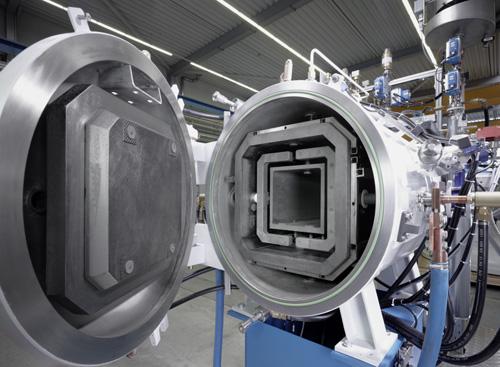Vacuum Sintering is the process of compacting and forming a solid mass of material by heat and/or pressure without melting it to the point of liquefaction.
Vacuum sintering is a process used to produce a hard metal, metal carbide and some ceramics part made from a metal injected powder metal and binder (MIM).
Injected metal and binder parts are loaded into a vacuum furnace. Furnace muffle is evacuated down to a base vacuum pressure under .5 Torr, then an inert gas such as Argon or Nitrogen (in special cases Hydrogen) is introduced to create a partial pressure between 1 -10 Torr.Temperature is slowly increased to between 850- 1100 C to vaporize the binder material. Material is carried out through a port fitted with a burn-off to safely decompose it, or can be collected in a heat exchanger and recycled.
After binder is completely removed, temperature is raised to just below the melting temperature of the material. This sinters and consolidates the powder into a monolithic net shape part.
A special case of vacuum sintering for very high performance parts is sinter/hot isostatic pressing.
After the binder is removed, the furnace is filled with inert gas as temperature is raised, causing the pressure to raise up to 100 Bar (100 times atmospheric pressure). This causes the part to be pressed as it is sintered, resulting in near theoretical density of the base material.
PVA TePla America’s sintering furnace are used on hard metals, cermets, rare earth (RE) magnets & MIM components. Our furnaces provide excellent temperature homogeneity and process control through all the process steps. Your materials will be fused together and create one solid piece with our vacuum sinter process. The system feature low gas consumption horizontal cold-wall furnace and a usable volume >=400 liters

Vacuum Sintering